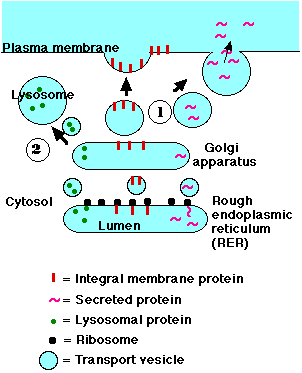
Lysosomes are roughly spherical bodies bounded by a single membrane. They are manufactured by the Golgi apparatus (pathway 2 in the figure).
They contain over 3 dozen different kinds of hydrolytic enzymes includingThe pH within the lysosome is about pH 5, substantially less than that of the cytosol (~pH 7.2). All the enzymes in the lysosome work best at an acid pH. This reduces the risk of their digesting their own cell if they should escape from the lysosome.
| At one time, it was thought that lysosomes were responsible for killing cells scheduled to be removed from a tissue; for example, the resorption of its tail as the tadpole metamorphoses into a frog. This is incorrect. These examples of programmed cell death (PCD) or apoptosis take place by an entirely different mechanism. Link to a discussion of apoptosis. |
Materials within the cell scheduled for digestion are first deposited within lysosomes. These may be:
| Link to discussion of how antigens are taken up by macrophages and B cells and degraded in their lysosomes. |
Peroxisomes are about the size of lysosomes (0.3-15 µm) and like them are bound by a single membrane.
They also resemble lysosomes in being filled with enzymes, of which catalase is the most characteristic. Catalase catalyzes the breakdown of hydrogen peroxide (H2O2), a potentially dangerous product of cell metabolism.
Peroxisomes may also break down other toxic molecules that get into the cell, such as beverage alcohol and many other drugs.
A number of other metabolic functions are carried out by peroxisomes but, except for the activities of catalase, no single function is common to all peroxisomes.
In animals, peroxisomes appear to be confined to the cells of the liver and kidney. In plants, the occur is a variety of cell types.
| Link to schematic showing lysosomes and peroxisomes in a typical animal cell. |
| Welcome&Next Search |